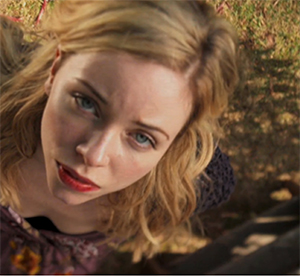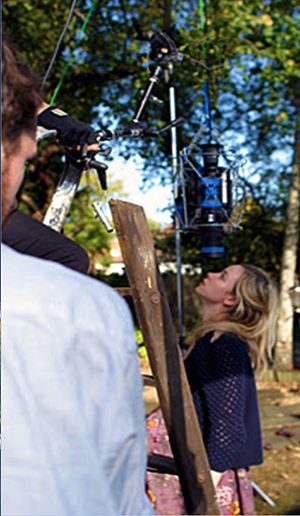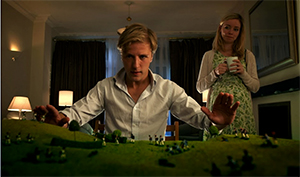- Accueil
- > Shakespeare en devenir
- > N°11 — 2016
- > The Eternal Not: Cinematographic Transgression or Cultural Mediation?
The Eternal Not: Cinematographic Transgression or Cultural Mediation?
Par Stéphanie Mercier
Publication en ligne le 22 novembre 2016
Résumé
The Eternal Not (2012)1, a four-character, fifteen minute short film written by Lucinda Coxon and directed by Joe Spray, is a dark comedy about a young married couple – Helena (Antonia Kinlay) and Bertram (Oliver Gomm) – who have been waiting for the birth of their first child for two years. Actually, rejected by her husband, Helena appropriates a strategy worthy of the romance tradition, although she is childless rather than dowerless here. Similarly, the film modernises the Shakespearean Bertram’s plans by having him consult an intermediary who advises him to commit « pseudocide » by running away to Cornwall or Scotland to definitively disappear from his wife’s clutches. Notwithstanding the transformations, the playgoer familiar with Shakespeare’s play All’s Well That Ends Well, written circa 1603-1604 will surely still recognise the nod in the film’s title to the letter that Bertram writes to his mother in act 3, scene 2 of the play – « I have wedded her, not bedded her, and sworn to make the “not” eternal ». The modern cinemagoer, even without any knowledge of the canon, will perhaps be intrigued by the unusual pun in the film’s name. Indeed, the enticing preliminary wordplay sets the scene for an incongruous story-line that is at once indicative of the four-hundred-year-old plot and yet enlarges upon the complexities of the Shakespearean couple’s fraught courtship and marriage. This paper will concentrate on how Spray guides the eye to cross over from seventeenth to twenty-first century fictional considerations and conciliate conventions of romance and satire, page, stage and film.
Texte intégral
1One anonymous summary on the IMDb website encapsulates The Eternal Not as follows: « Paranoid, he wants to disappear forever, and plans to help fake his own death. She has a gift for patience, but her delusions are challenged by her GP [Matthew Hickley]. A darkly comedic tale of eternal longing based on Shakespeare’s All’s Well That Ends Well2.» Indeed, if the film is centered in impersonal office surroundings or cloistered in a claustrophobic, heavily curtained suburban set, its outcome seems as equally as stifling as the play’s courteous conclusion: Helen’s powerful and needy desire for Bertram completely closes off their relationship to stress pathos and passion to the end. This study of The Eternal Not will thus be arguing that Joseph Spray’s film does successfully transgresses, in the etymological sense of going « across, […], over, [and] beyond3», boundaries to provoke a similar type of response from modern audiences that Shakespeare’s play most probably did just over four centuries ago. In other words, the impression that Bertram, to coin Dr. Johnson’s phrase, is « dismissed to happiness4» and that the auspicious fatality of him being rescued from his own self-treachery is worked out, not by an outer goodness, but by Helena’s human agency. In play and film, his potentially terrible acts hence lead, not to the overwhelming universal disaster of the tragic world but to what Jonas A. Barish terms as « untragic fulfillment5», whose uncomfortable ambivalence leaves us feeling unsettled rather than daunted, frustrated rather than jubilant, by the end of the plot. Indeed, both play and film vividly transpose, what one on-line reviewer of Coxon’s version of the play has termed as the « unspoken but perceptible in a few notorious Shakespeare couplings – those that come about through force, trickery or deceit: that is, the power of wilful ignorance and the strength of desperate love6» to result in scenarios « where genres and value systems are calculated to jar7».

Helena (Antonia Kinlay), Bertram (Oliver Gomm). Still from the final minutes of Joe Spray’s The Eternal Not (2012).
© Joe Spray.
2This leads us to ask what these two versions of an unorthodox comedy, even for Shakespeare’s time, can tell us about our ability to counter conventional fictitious frontiers and move into a world where the masculine quest-romance pattern is attributed to the female and the « marital prize male8». Furthermore, how does the fusion of the established and the innovative, in what may be termed as cooperative past and present creation, enable the spectator to appropriate these differences9? Accordingly, after some background on the transformative elements already inherent to play with regards to its sources, in what manner this particular cinematographic enactment of Shakespeare’s story helps cross over persistent (conformist) dramatic expectations will be examined. Then, why both linguistic and visual re-creation is fundamental when confronting any « truth » of the manner in which All’s Well that Ends Well should be staged or adapted will be looked at – in order to decipher whether such reworking is not merely transgression but rather cultural mediation in its own right.
I. In hot pursuit
3Dramatic transgression is not unique to millennial revisions such as Spray’s. As the Arden edition of Shakespeare’s All’s Well That Ends Well edited by G. K. Hunter notes, for example: « From whatever version he derived the story, [Shakespeare] was not content to present exactly as he found it and made a number of changes in emphasis and effect10 ». The resulting play, first published in the 1623 First Folio, was thus already conceivably a hybrid of two « prompt copy11 » performance texts or perhaps even, due to numerous discrepancies that scholars have found in speech prefixes along with the work’s unsophisticated and disjointed nature, a « foul-papers copy12 ». To back up this latter view, Hunter lists inconsistencies such as ambiguous stage directions, silent entries, presences of ghosts and songs as part of context13 that give the lie to any purist conception of the play as an infallible and aesthetic whole from the outset. Pondering over the history of All’s Well That Ends well requires some mental gymnastics even with regards to the play’s title. A Bad Beginning makes a Good Ending, Loves Labours wonne14, are two former headings that immediately point to the volatility of Shakespeare’s artistic creation. The adaptation of former structural outlines and imaginative aspects from diverse sources also testifies to mixed stimuli for the play. It is generally held that Shakespeare found dramatic inspiration in the « ninth novel of the third day in Boccaccio’s Decameron, which is not known to be based on any other extant piece of literature15». However, if, as most scholars claim, the playwright did not directly go to Boccaccio’s tale, it was because he consulted William Painter’s late sixteenth-century Palace of Pleasure (1566, 1569, and 1575) that translates both the Italian Decameron and its French version by Antoine le Maçon – or perhaps even, because Shakespeare had some knowledge of French, directly by means of the Gallic adaptation without its English intermediary16. The texts, read to construct the fiction that was finally to be called All’s Well That Ends Well, were consequently variations upon an original fabrication themselves, that is, linguistic re-inventions, in two different languages, of the original text.
4Shakespeare’s synthesis of his miscellaneous sources then involved further adaptation. G. K. Hunter attests to modifications such as dramatic compression of time to strengthen the effect of speed and tension. Differences include, for instance, the fact that both Helena and Bertram’s fathers die simultaneously, Helena promises to cure the king in two days instead of eight or that the opportunity for the « bed trick » happens only once17. The attempt to demote Bertram and promote Helena in the audience’s esteem is also Shakespeare’s. For example, the King of France is seen to insist on what is a socially inappropriate marriage and Bertram cowardly writes, rather than speaks up for himself, to his wife – all in all, this is a variant that gives the impression, not that she is covetous, but that she is legitimately responding to her husband’s aloof epistolary cruelty18. Moreover, Bertram’s untruths and escape attempt are Shakespearean inventions that reinforce a sympathetic response to Helena’s assertive endeavours to win back her husband. Not content with reversing audience reaction to the main characters in inverse proportion to the source texts however, Shakespeare further reinforced the question of honour in his play. Indeed, although Helena has nothing more than her virtue to vouch for her, Bertram flippantly exchanges his family ring – the symbol of centuries of generations of nobility – for Diana’s virginity19. In addition, spatial concentration was also intended to provide coherence to the plot. The relationship between the French and Italian scenes that Shakespeare introduced to the play, as Hunter notes:
[gives] reality to both the political and political aspects […], so that his characters are never allowed to stray into an area of moral irresponsibility; the Italian scenes are not merely a background for romantic adventure, but a new setting for the old, accumulation, moral account20.
5All these changes come with more important deviations such as the introduction of new characters such as the Countess, Lavatch, Lafew, the King of France, and Parolles. Their addition perhaps intended to define a « norm of propriety against which the tale of Bertram and Helena is seen in added moral perspective21», presents a conflict of values between old and new generations or simply provides added dramatic interest to existing texts depending upon the viewpoint taken. Whatever the original objective, becomes apparent the heterogeneity of versions housed within the ultimate umbrella termed « Shakespearean text ». This surely makes it worth allowing for the possibility for offshoots from the source material that may be justified by the existence of not one, but numerous, inspirational narratives and multilingual varieties of the play’s primary version.
6One of these derivatives is thus Spray’s film that came about as a graduation project from his time at the London Film School. It was itself adapted from Lucinda Coxon’s play, The Eternal Not (running time 30 minutes) that was initially a companion piece commissioned by the National Theatre to its 2009 stage production of All’s Well That Ends Well, and performed for free in the foyer before the main show. Spray approached Coxon and obtained her agreement to halve the length of the script for the project before partly financing the venture with funds reinvested by the school where he was a student. The whole budget of approximately £ 5,000 was used up on production, or the shooting, of the film, so, post-production (editing, colour grading, sound mixing and music) which cost around £ 1,500, was crowd-funded on the website « INDEGOGO », where it was posted as: « A surreal black comedy about a man who wants to disappear and a wife who won’t let go22». Benefactors included: « I want to disappear », « Married », « Formidable Enemy » or « Escapee » – at once entertainingly obvious, if necessarily anachronistic, responses to both Shakespeare’s play and a counterpart that is undeniably modern in its conception and procedure. At the same time, they provide a commentary on the text’s evolution and hint at connexions between a four-century old production and this particular alteration. Indeed, it is impossible not to countenance possible correlations between the texts because to do so would be to deny the primary divergences and their productive dimensions. For example, if the Shakespearean play ends with Bertram forced, under royal duress, to renounce to Helena any claim he might as Count of Roussillon or husband have on his manhood: « If she, my liege can make me know this clearly/ I’ll love her dearly, ever ever dearly » (V.3.312-313), in Spray’s film, the heroine no longer even needs the king’s intercession to assert her due. From this particular illustration emerges how the same story can be cast into a different medium and adapted to suit a modern audience. Therefore, secondary characters such as the King of France or the Countess of Roussillon are omitted, there is no trace of Lafew, Lavatch or Parolles, the language of the play is rewritten and the comedy even seems to have been altered at times into a psychological thriller, a worthy successor of Hitchcockian suspense.
7On the other hand, if the film’s dramatic action is to offer a current day understanding of Shakespeare’s plot, simple reverberation would hardly seem enough. In other words, Helena’s combined « single-minded determination and sense of election at being a channel for impersonal forces23» leading her at once to suppose « that love can be earned, that she can somehow deserve Bertram24» cannot be conveyed by words alone. Likewise, the impression that her husband is« more acted upon than acting25 » or « being asked to love to order26» whilst remaining the « adolescent of the earlier scenes, ready to trivialise all of his experience27 » requires effectual representation to elucidate a story that still runs contrary to the customary romance-narrative. This is especially true as the final product was intended to appeal and make sense to a modern, global, audience – the film was given international viewing at the 36thRencontres Henri Langlois International Film School festival, held in Poitiers, in 2013 for instance28. Helena’s « heightened risk-taking29» and Bertram’s « astonished anger30» at becoming a trophy must thus be conveyed visually as well as aurally for the contemporary spectator, whether an English speaker or not.
II. Contrast of Scale
8The major departure from Shakespeare, or even Coxon’s, modifications was Spray’s cinematographic medium. Undoubtedly, this modern performance of the play is given supplementary magnitude, and increased legitimacy, by its communication of a narrative on screen. In this, the comprehension of the past fiction can be understood differently, as both a reconstruction and a re-invention of Shakespeare’s play. Within the framework of the original (upturned) romantic comedy, Spray’s film insists then that we contemplate the politics of modern married relationships and their various configurations while All’s Well That Ends Well still engenders inspiration that finds parallels in the film. For example, the motifs of seeing and believing, disguise and mistaken identity that are manifest in Shakespeare’s work, also influence Spray’s. A case in point is that there are no less than eighteen instances of the term « eye » and Helena refers once to « imagination » (I. 7731) and seven times to « love » in the very first scene of the play. These preparatory elements also appear in the film to provide a more up-to-date understanding of spectatorship thanks to the quote from the novelist Patricia Highsmith – « The essence of love is imagination, it has nothing to do with reality at all, it is all in the eye of the beholder32» – which provides a similar introduction to the action. This example surely points to how differing treatments, within unrelated dramatic spaces, can still tell a similar story by use of textual interplay.
9The interaction is further accomplished via the persuasive power of camera, whose movements work incredibly well in transcribing the power of Coxon’s text. For example, when we first see Helena, it is from a high-angle shot, which should objectively make the person filmed seem vulnerable, especially here as the female character is purported to be heavily pregnant.

Helena (Antonia Kinlay) from a misleading high-angle shot. Joe Spray’s The Eternal Not.
© Joe Spray
10However, the shot is misleading as Helena is not the stereotyped submissive woman convention expects her to be and this is made clear as the camera moves out of focus and then refocuses on her eye33. The effect achieved functions, amongst other things, because it emphasises the fact that we should be wary of Helena’s, and our own, subjectivity whilst translating Shakespeare’s uncommon take on traditional romantic comedy by insisting that we scrutinise the ultimately unseeing eye of a heroine determined to triumph over an unwilling hero, who will ultimately have to renounce any claim to his own idealistic reality at the end of the plot.



Helena (Antonia Kinlay) being filmed by Joe Spray.
© Joe Spray
The backstage pictures can be found individually on The Eternal Not’s Makeup Artist Rachel Good’s blog ‘pointlessprettythings.blogspot.fr/2011_11_01_archive.html’
11Neither Helena nor Bertram are presented by romance tradition in this version. The camera initially films Bertram with a low angle-shot, quite usual if the director wishes to focus on the dominance and power of an authoritative male character – especially as he wears a suit and is framed within a business environment. However, Bertram is beforehand seen nervously turning over a visiting card as he arrives for his appointment with the mysterious office-administrator Kelly (Mary-Frances Doherty), whose role in the plot is to aid the fleeing husband to escape his wife. Also, Bertram’s squirmy uneasiness and childish reactions to Kelly’s pertinent questions as to why he wants to leave his wife on the day after their wedding anniversary hint at the dumbfounded spoiled child in men’s clothing who cannot quite understand why he will never be able to have his own way.

Bertram (Oliver Gomm). Joe Spray’s The Eternal Not
© Joe Spray
12Our fictitious expectations are further thwarted by a cunning use of camera depth. As Bertram arrives at Kelly’s office, the close up on the back of his head is in a stark contrast of scale to the long-shot on Kelly – almost as if we are looking through Bertram’s eyes to glimpse his inaccessible dream of running away. And, within this environment of increasing desperateness, the full shot that makes Kelly appear relatively small in the frame stresses not her, but Bertram’s, sense of defeat of never being able to rid himself of Helena. Furthermore, the long-depth field highlights the distance between his fiction and her realism as, for instance, when she tells him « it isn’t real », whilst he stubbornly refuses to accept the facts. Additionally, Kelly and Bertram’s dialogue is filmed in shot reverse shot, which creates a mental link between the two characters – but just as efficiently highlights their differences as they are never in the same shot together and are shown facing in differing ways. This treatment could possibly remind those who have seen the play of the King’s: « Is there no exorcist/ Beguiles the truer office of mine eyes?/ Is’t real that I see? » (V.3.302-3), necessitating a transfer of our vision of the Shakespearean events from stage to screen and a renovation of comprehension in the process.

Kelly (Mary-Frances Doherty). Joe Spray’s The Eternal Not.
© Joe Spray
13Then, Helena suddenly appears behind Bertram as if by magic in the office.

Bertram (Oliver Gomm), Helena (Antonia Kinlay).Joe Spray’s The Eternal Not
© Joe Spray
14This, before she tails her husband in the set of the couple’s living room – which is sequestered by heavy curtains to make a visual statement about the oppressive void of their relationship. Indeed, in this scene Bertram, flattering himself into manhood and preferring toy soldiers to real life encounters, engages in a mock bloody defeat for the French of the Battle of Borodino (1812). Like Napoleon, he will thus miss his chance of engaging in a vigorous confrontation, doing away with the enemy and winning the fight – for example over the reasons for his wife’s phantom pregnancy and the impassioned desolation of her desire for him.

Bertram (Oliver Gomm), Helena (Antonia Kinlay).Joe Spray’s The Eternal Not
© Joe Spray
15All through, the short-depth filming gives the impression that Helena is in hot pursuit of Bertram. The way the camera narrates their ensuing conversation – she talking to the back of his head and his replies seemingly spoken in solipsism – also hints at how the characters are conversing with themselves rather than with each other. The only word truly exchanged with eye contact is « passion », although neither character, whilst consistently seeming to exhibit the « suffering of pain […], [the] being acted upon, [the] powerful amorous feeling [or] sexual impulse34» that the term implies, possesses the maturity to express its significance. This is extremely appropriate with regards to the play as it is the Countess, Helena’s surrogate mother figure, who almost exclusively uses the word « passion », three times in act I, scene 3 (lines 117, 158, 174). This, as she progressively imposes its semantics upon her future daughter-in-law in a transmission of an outmoded model of marriage – a notion that will be transformed by Helena into an early modern business contract with the King (II.1) so as to upstage any masculine domination of courtship from that moment on.

Helena (Antonia Kinlay), Bertram (Oliver Gomm). Joe Spray’s The Eternal Not
© Joe Spray
16Perhaps the finest example of how Spray’s film underlines Helena’s hold on her husband and the impossibility of his parting is the match cut between the shot of the apple juice that she has substituted for her pregnancy test urine to falsify the results and that of the glass of « something cold » that he expediently drinks in Kelly’s office. Apart from the surprised laughter that the earthy humour of mental association produces – the cut initially gives the impression that he Bertram is drinking Helena’s urine – this is a metaphoric reminder of how the characters’ parallel fictions are to be linked forever. Indeed, Helena will encircle her husband at the close of the film – to undress him, as if he were a child and in an optical statement about the encounter between isolation and substitution considered by both the play and the film. Spray’s direction here without doubt evokes Shakespeare’s fiction in its nod to the cold ring that Bertram squanders on Diana in the play and how « the revelation of it on her finger makes public the extent of his offense, [and] expos[es] the hollowness of the honour in behalf of which he has turned away Helena35» even if she seemingly reconquers him at the end.
17Thus in Spray’s film, as in Shakespeare’s play, our traditional responses as an audience are challenged. Moreover, the camera creates two kinds of reasoning, the one that we have been trained to by an uncountable number of old folktales and decades of stereotypical cinematography and the kind of Shakespearian complexity that refuses such Manichean divides to turn things inside out and make the difference in conventional sexual expectations vividly clear. As the Shakespearean audience, the cinema spectator can admire the infatuated Helena, for her ingenuity, but also sympathize with her as she is seen to be more in love with the idea of being in love than with Bertram himself. Furthermore, in the film as in the play she stubbornly remains convinced their relationship will succeed despite this one-sidedness. A similar, although inverted, approach can be adopted with regards to her caddish husband who is both callous and small-minded but is also shown to be the loser from beginning to end. And, both theatrical and cinematographic treatments provoke the same mixed feelings because, to quote Spray:
We can feel sorry for [Helena] because she is so convinced she loves [Bertram] but he does not love her back and for love to work it has to be on par. At the same time he achieves redemption because of his childish stupidity and because audiences always sympathise with the underdog[we are] totally subjective […] just like the whole idea of love itself36.
III. Ambush
18In this way, Spray’s film version of All’s Well That Ends Well undoubtedly still offers a convincing cinematographic, albeit anachronistic, interpretation of Shakespeare’s own ground breaking understanding of the comic model. Both versions of the story propose the construction of a conflict between self-sacrifice and self-fulfilment. They also acknowledge a more modern understanding of chivalric romance – the loyal (female) suitor, although rejected by her companion, recaptures her beloved’s heart (notwithstanding the theoretically dishonest bed trick that allows her to do so). Indeed, the second version even remains loyal to the importance and implication of Shakespeare’s text: Helena fights for Bertram, he capitulates. Furthermore, both share a satirical take on the societal grading of romantic values and the distribution of comedy into more serious, absurd or even uncomfortable situations. It is even possible to argue that both present textual similarities that suggest that Shakespeare’s work is transmitted to, rather than transgressed by, Spray’s film.
19In fact, the notions of parentage and transference that are so crucial to the birth and body of Shakespeare’s dramatic action also underpin the film’s realisation and frame. In the play, the Countess’ repeated use of the term « mother » – twelve times in the same scene in which she induces passion, of which eight in the space of only twelve lines (I.3.124-36) – linguistically inseminates Helena’s own speech to the extent that she refuses to become Bertram’s sister to become a « mother » in her own right. This empowers Helena with a vigour that George Bernard Shaw qualifies as « an early dramatic instance of the life force, the energy of the race manifesting itself in the feminine drive for procreation37 ». And, if the film curtails the character of the Countess, it nonetheless replaces her voice with the voiceover and re-enactment of Spray’s forceful Helena explaining to her General Practitioner, Mike, how she discovered she had become « pregnant » nearly a year before. Thus, although in a different manner, the cinematographic device reinforces and consolidates the representation of the character of Helena while underlining the shared folklore and symbolic journey on her imagination, just as the rhetoric does in Shakespeare’s drama. Only in the film, the overbearing Countess seems unnecessary in a world where more modern individual considerations better depict the painful discrepancy between the spouses’ respective desires.
20The film, as Shakespeare’s text, also establishes comic correspondences between the individual and the « commonwealth » (I.1.120), personal emotions and geopolitical situations. In All’s Well That Ends Well, Helena is both an orphaned descendant of a lowly doctor and the ward of the Countess of a whole region of France, a subservient female and an assertive soldier, seeking authority over Bertram through the restoration to health of an ailing king and thence subverting the traditional early modern concept of womanliness. The witty banter between Helena and Parolles around the perception of Helena’s virginity perhaps best expresses this strategy of significances relating to legitimacy, influence and control. For instance here, where Helena articulates the difficult balance of power within marital relations:
Not my virginity yet […]
There shall your master have a thousand loves,
A mother and a mistress and a friend,
A phoenix, captain and an enemy,
A guide, a goddess, and a sovereign,
A counsellor, a traitress, and a dear:
His humble ambition, proud humility,
His jarring concord, and his discord dulcet,
His faith, his sweet disaster; with a world
Of pretty, fond, adoptious christendoms,
That blinking Cupid gossips. Now shall he –
I know not what he shall. God send him well.
The court’s a learning place, and he is one – (I.1.152-164)
21In acquiescence with the legacy of the romance archetype, Helena prepares to offer her love to Bertram. Then again, the chivalric concept is transformed as Helena refers not to an exclusive love intended to rise above all other considerations but to multitudinous loves contained under the overriding authority of « virginity » – designed to produce what Parolles describes as « rational increase » (I.1.121) and that will allow her to attain more elevated fortune than her humble birth had destined her to. Shakespeare unambiguously uses metaphors that suggest these contradictions to custom and Helena’s seditious mission is openly affirmed by the use of conflicting terms such as « captain » and « enemy » (I.1.155) that very efficiently foreground the oxymoronic « jarring concord […] sweet disaster » (I.1.159) of her relationship with Bertram to be.
22If the loss of one’s virginity is less problematical nowadays, the film nonetheless firmly establishes a similar relationship between the individual and the state in a confrontational atmosphere to produce the same effect as the play – that Helena possesses a power that is both intimidating and treacherous. Apart from this point being immediately underlined by the visual and linguistic reference to the Battle of Borodino, the idea of a territorial attack upon Bertram’s person is consolidated by language all through. Indeed, when Kelly reminds Bertram of his marital obligations, he attempts to preserve his position using combat vocabulary of withdrawal: « it was an ambush », « my wife is a formidable enemy », « I kept moving ». Moreover, the bed trick, if somewhat « mechanical and expedient, too remote from the nuances of the situation it is asked to catalyse » and yet which « resolves complications38» in the play is also evoked by Bertram with military metaphor in the film – « they struck in tandem […] a Pincer movement ». There thus remain strong hints of Shakespeare’s Helena by use of self and state-orientated metaphors that remain faithful to the play’s intention of drawing analogies between her machine-like motivation and the invasion of Bertram’s body with the intent of capturing his heart. In point of fact, in Spray’s film Helena uses a vocabulary of military assault that provides a counterpoint to Bertram’s lexical field of retreat: « my husband went off […] so I went out into the world and I fetched him home », or « I tracked him with a GPS ». Apart from the audible verbal vehemence of the strong verbs such as « fetch » or « track » that affirm an obvious determination in concordance with the early modern Helena, her piqued annoyance is just as at odds with the traditional notions of feminine compassion – a contradiction in terms originally expressed by Shakespeare.
23In other words, the film, as the play, conveys all through a strange « sense that events are moving darkly39». Both subvert the emotional tension that the portrayal of the hitches, hindrances and final happy ending of traditional romantic comedy. This confronts dramatic standardization and encourages audiences to question their conceptions and expectations of generic reliability. Or, and as the Second Lord puts it: « The web of our life is of a mingled yarn, good and ill together; our virtues would be proud if our faults whipped them not, and our crimes would disappear if they were not cherished by our virtues » (IV.3.65-66). And, if the forced reunion of Helena and Bertram at the end of the story persists in the film, the story’s outcome also preserves the disillusionment of any future wedded bliss to point to a disunity of tone and further soul searching rather than to satisfactory closure.
24Spray’s film is ultimately successful in its « transgression », or crossing over, because it takes the « mingled yarn » of Shakespeare’s story and investigates it further. In this respect, it is not a simple retelling of All’s Well That Ends Well because, while the combination of popular folklore and eccentric comedy continues to be tenaciously present (although in a tauter theatrical arrangement), cinematographic methods bring out all the complexities of the individual mind with an equivalent artistic integrity and innovation to Shakespeare’s for a modern audience. Indeed, the cultural intricacies of Renaissance social differences or sexual restrictions are hard to transpose in any language, yet Spray’s film responds to and transits from the inheritance of Shakespeare’s inside-out romantic comedy to create his own self-reflexive psychological entertainment. He does so using cultural mediation that communicates the original play by the use of multitudinous camera angles, depths and textual transitions – that allow the viewer to take stock of both the figurative and the literal with limited resources and in very much the same manner as the inventiveness of the original theatrical improvisation of Boccaccio’s tale.
25Undoubtedly the two artistic products are not identical – nonetheless the latter is closely linked to the former as both share a story, characters with similar personalities and both retain the ambiguity of ending that denies the certainty of happiness traditionally associated with the comic genre. This imaginative resourcefulness in fact much resembles the three stages of the process of « pseudocide » as advised as an (unsuccessful) escape strategy by Kelly to Bertram – « the erasing of your present identity, the creating of a misleading smoke screen, the establishment of a new identity ». In other words, a fictional process will function just as long as we believe in the narrative and the identities of the characters that make up the folk-tale. Moreover, the crossings inherent to both, one of Shakespeare’s most thought-provoking plays and Spray’s inventive short film, transport us into the realm of illusive truth to liberate shifting narrative formulation and our own imaginative interpretations just as far as we are willing to take them. Both Shakespeare’s and Spray’s representations thus open up new possibilities for interpretation of Boccaccio’s story and their development upon the original account is designed without doubt to expose the insufficiency of any notion of dramaturgical immovability.
Bibliographie
Primary sources
Shakespeare, William, All’s Well that Ends Well, ed. G. K. Hunter, London, Thomson Learning, “The Arden Edition of the Works of William Shakespeare”, [1959] 2006.
Shakespeare, William, All’s Well That Ends Well, ed. Alfred Harbage, London, Penguin Books, “Complete Pelican Shakespeare”, 1969.
Shakespeare, William, All’s Well That Ends Well, ed. by Stephen Greenblatt, Walter Cohen, Jean E., Howard and Katherine Eisaman Maus, London and New York, W.W. Norton & Company, “The Norton Shakespeare”, 2008.
Other readings
Barish, Jonas A., “Introduction to All’s Well That Ends Well”, ed. Alfred Harbage, London, Penguin Books, “Complete Pelican Shakespeare”, 1969.
Eisaman Maus, Katherine, “Introduction to All’s Well That Ends Well”, “The Norton Shakespeare”, London and New York, W.W. Norton & Company, 2008.
Esslin, Martin, An Anatomy of Drama, New York, Hill and Wang, 1976.
Johnson, Samuel, Johnson on Shakespeare, ed. R.W. Desai, London, Sangam Books Limited, 1979.
Onions C.T, ed. The Oxford Dictionary of English Etymology, Oxford, Oxford University Press, 1966.
Wilson, Andrew, Beautiful Shadow: A Life of Patricia Highsmith, London, Bloomsbury, [2003] 2010.
Web resources
http://www.britishtheatreguide.info/otherresources/Latitude/lat09-4.htm
http://www.imdb.com/title/tt2233590/plotsummary?ref_=tt_ov_pl
https://www.indiegogo.com/projects/the-eternal-not-short-film
http://pointlessprettythings.blogspot.fr/p/about.html
Notes
1 For the trailer go to https://vimeo.com/64664155
2 http://www.imdb.com/title/tt2233590/plotsummary?ref_=tt_ov_pl
3 [Trans- transgress], The Oxford Dictionary of English Etymology, ed. C.T. Onions, Oxford, Oxford University Press, 1966, p. 936
4 Samuel Johnson, Johnson on Shakespeare, ed. R.W. Desai, London, Sangam Books Limited, 1979, p. 70.
5 William Shakespeare, All’s Well That Ends Well, ed. Alfred Harbage, London, Penguin Books, “Complete Pelican Shakespeare”, 1969, Introduction by Jonas A. Barish, p. 324.
6 http://www.britishtheatreguide.info/otherresources/Latitude/lat09-4.htm
7 http://www.independent.co.uk/arts-entertainment/theatre-dance/reviews/theatre-review-alls-well-that-ends-well-royal-shakespeare-theatre-stratforduponavon-8733210.html
8 William Shakespeare, All’s Well That Ends Well, ed. Stephen Greenblatt, Walter Cohen, Jean E. Howard and Katherine Eisaman Maus, London and New York, W.W. Norton & Company, 2008, “The Norton Shakespeare”, Introduction by Katherine Eisman Maus, p. 2193. All quote references are from this edition.
9 See Martin Esslin, An Anatomy of Drama, New York, Hill and Wang, 1976, p. 33.
10 William Shakespeare, All’s Well that Ends Well, ed. G. K. Hunter, , London, Thomson Learning, “The Arden Edition of the Works of William Shakespeare”, [1959] 2006, Introduction, p. xxvi.
11 Ibid., p. xi.
12 Ibid., p. xiii.
13 Id.
14 William Shakespeare, All’s Well that Ends Well, ed. G. K. Hunter, op. cit., Introduction, p. xix.
15 Ibid., p. xxv.
16 Id.
17 Ibid., p. xxvii.
18 Id.
19 Ibid., p. xxviii.
20 Id.
21 Id.
22 https://www.indiegogo.com/projects/the-eternal-not-short-film
23 http://www.independent.co.uk/arts-entertainment/theatre-dance/reviews/theatre-review-alls-well-that-ends-well-royal-shakespeare-theatre-stratforduponavon-8733210.html
24 William Shakespeare, All’s Well That Ends Well, ed. Alfred Harbage, op. cit., p. 323.
25 Ibid., p. 322.
26 http://www.independent.co.uk/arts-entertainment/theatre-dance/reviews/theatre-review-alls-well-that-ends-well-royal-shakespeare-theatre-stratforduponavon-8733210.html
27 William Shakespeare, All’s Well That Ends Well, ed. Alfred Harbage, op. cit., p. 324.
28 http://www.rihl.org/festival2013.php
29 William Shakespeare, All’s Well That Ends Well, ed. Stephen Greenblatt, Walter Cohen, Jean E. Howard and Katherine Eisaman Maus, op. cit.,, p. 2193.
30 Id.
31 « My imagination/ Carries no favour in’t but Bertram’s / I am undone. There is no living, none / If Bertram be away » (I.1.77-80).
32 In his biography of the novelist, Andrew Wilson notes that when Highsmith was asked about the nature and essence of love in an unpublished interview with the journalist Bettina Berch she replied ‘Imagination. […] Because it’s all in the eyes of the beholder. Nothing to do with reality. When you’re in love it’s a state of madness’ Andrew Wilson, Beautiful Shadow : A Life of Patricia Highsmith, London, Bloomsbury, [2003] 2010, p. 55.
33 In point of fact, the in/out of focus movement was a happy mistake as the team would not afford the extra cost of a crane so they went to a garden centre and bought a wire mesh plant pot holder. Then, with a pulley, the camera was dropped down from the plumb tree where hundreds of ripened fruit hung (moreover, there were, no plums in the tree so they had to be tied on individually and it took a whole morning to do it as shooting was off-season).
34 [Passion], The Oxford Dictionary of English Etymology, op. cit., p. 656.
35 William Shakespeare, All’s Well That Ends Well, ed. Alfred Harbage, op. cit., p. 322.
36 Interview carried out during the 2013 Henri Langlois Festival.
37 William Shakespeare, All’s Well That Ends Well, ed. Alfred Harbage, op. cit., p. 322.
38 Ibid., p. 323.
39 Id.